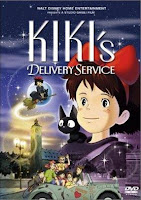
Kiki’s Delivery Service. Dir. Hayao Miyazaki. 1989. 103 min. Rated G.
The film starts at the beginning of a journey. As dictated by traditional custom, young Kiki is granted independence at the age of thirteen so she may begin the year-long training away from home to cement her status as a bona fide witch. She leaves behind her loving parents and small town and relocates herself to a large city, which (though nonexistent) has distinctly European features. However, she soon learns that the rules of the city (and life) are not quite as she imagined.
Eiko Kadono, author of the book on which the film is based, and Hayao Miyazaki, the screenwriter and director, are both Japanese. Although the film takes place in a made-up world, it can be said that those who craft the film leave their own mark on the story, demonstrating the proper values thought important. Kiki demonstrates the archetypal Japanese trait of showing respect for her elders.
Since she has no special talents (except for flying on a broom, which she does haphazardly at best), her training consists of learning how to support herself, which she accomplishes by establishing an air delivery service (via broomstick). Kiki’s growth as a character evolves through her interaction with her customers. At least three of her female customers act as second mothers, aiding her in the gradual transition from the sheltered childhood she knows into the reality of young adulthood. This supportive network of parental-substitutes allows Kiki, and young viewers, as well, to explore her new environment safely. Kiki’s work ethic is impressive in a child so young. She earns the respect of adults through her earnest and diligent behavior. She also learns that items she took for granted before (food, cooking implements) cost money and can be somewhat expensive. She cooks and cleans for herself, and finds herself scrimping when money is low. Although she longs to own nice clothes, she notices that even the price on a pair of shoes she admires in a store window is equal to, or more than, the amount she spends on groceries alone.
Even though Kiki serves as a role model towards young children, she also stands as a figure they can empathize with. She has the same doubts and disappointments as everyone else. Her stay in the city, for example, doesn’t begin as well as she had hoped. The city is not warm and inviting like her hometown. Her attempts to introduce herself to strangers are at first met with indifference. She is insulted when an incredulous hotel desk clerk doesn’t believe her when she asks to rent a room without her parents present. “No one seems to like witches in this town,” she observes sadly. Her sense of alienation is present whenever she is around children her age. When her new friend (and love interest) Tombo introduces her to his usual gang of friends, she finds herself unable to relate to them. She feels herself to be “an outsider.” Her insecurities and failed self-confidence affects her ability to do magic: she can no longer fly a broomstick, and she can no longer communicate with her black cat, Jiji. She feels lost without the very thing that makes her feel special. Her host family and friends give her the emotional support she needs to regain her self-confidence. It is put to the ultimate test when she is the only one who can save Tombo, who is dangling from a rope attached to a runaway dirigible and faces certain death if he falls.
Kiki’s Delivery Service is a sweet, lovely film about what happens when life disrupts our preconceived notions, and the sense of loss and insecurity which takes place after. The pacing is sometimes slow and methodical that might not work with younger elementary students. With its discussion of teenage independence, it will probably have the most developmental impact for children in their preteens. Recommended for Ages 9-12, this is also a film that parents, too, can appreciate.
Click on cover for image source.
No comments:
Post a Comment